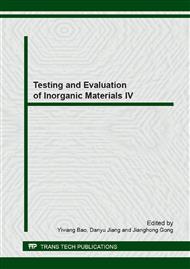[1]
Kobayashi K, Kuwajima H, Masaki T. Phase change and mechanicalproperties of ZrO2–Y2O3 solid electrolyte after ageing, Solid State Ionics. 3-4(1980)489–93.
DOI: 10.1016/0167-2738(81)90138-7
Google Scholar
[2]
J.A. Muñoz-Tabares, M. Anglada. Hydrothermal degradation of ground 3Y-TZP, Journal of the European Ceramic Society. 32 (2012) 325–333.
DOI: 10.1016/j.jeurceramsoc.2011.08.029
Google Scholar
[3]
Kosmac T, Oblak C, Marion L. The effects of dental grinding and sandblasting on ageing and fatigue behavior of dental zirconia (Y-TZP) ceramics, J. Eur Ceram Soc. 28(2008)1085–90.
DOI: 10.1016/j.jeurceramsoc.2007.09.013
Google Scholar
[4]
Jue JF, Chen J, Virkar AV. Low-temperature aging of t-zirconia: the role of microstructure on phase stability, J Am Ceram Soc. 74(1991)1811–1820.
DOI: 10.1111/j.1151-2916.1991.tb07793.x
Google Scholar
[5]
Junya Kondoh, Aging strengthening of 8 mol% yttria-fully-stabilized zirconia, Journal of Alloys and Compounds. 370 (2004) 285–290.
DOI: 10.1016/j.jallcom.2003.09.025
Google Scholar
[6]
Sergo LV. Low temperature degradation ageing of zirconia: a critical review of the relevant aspects in dentistry, Dent Mater 26(2010)922.
Google Scholar
[7]
Masatoshi Hattori, Yasuo Takeda, Yoshinori Sakaki, Effect of aging on conductivity of yttria stabilized zirconia, Journal of Power Sources. 126 (2004)23–27.
DOI: 10.1016/j.jpowsour.2003.08.018
Google Scholar
[8]
Kondon J, Shiota H, Kikuchi S, Tomii Y. Changes in aging behavior and defect structure of Y2O3 fully stabilized ZrO2 by In2O3 doping. Journal of the Electrochemical Society. 149(2002) J59–J72.
DOI: 10.1149/1.1486242
Google Scholar
[9]
Hattori M, Takeda Y, Sakaki Y, Nakanishi A. Effect of aging on conductivity of yttria stabilized zirconia. Journal of Power Sources. 126(2004)23–27.
DOI: 10.1016/j.jpowsour.2003.08.018
Google Scholar
[10]
Haering C, Roosen, A. and Schich H, Degradation of the electrical conductivity in stabilised zirconia systems. Part I. Yttria-stabilised zirconia. Solid State Ionics. 176(2005)253–259.
DOI: 10.1016/j.ssi.2004.07.038
Google Scholar
[11]
Butz B, Kruse P, Störmer H. Correlation between microstructure and degradation in conductivity for cubic Y2O3-doped ZrO2, Solid State Ionics. 177( 2005)3275–3284.
DOI: 10.1016/j.ssi.2006.09.003
Google Scholar


